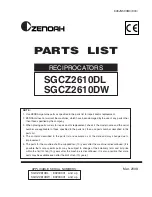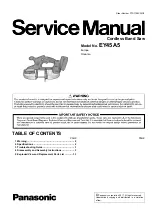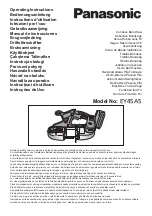
24
PLAIN (PINLESS) BLADES
Removing Saw Blade
• Turn off the saw and unplug from power source.
• Pull up on the tension release.
• Turn blade tension knob counterclockwise to decrease
(or loosen) blade tension.
• Pushing up from under the saw table, remove the throat
plate.
• Loosen both the upper and lower blade clamp screws.
• Loosen Set screw on Top and Bottom Blade mounting
cylinder
• Remove Blade
Replacing Saw Blade
• Turn off the saw and unplug from power source.
• Place plain (pinless) blade through center hole of blade
mounting cylinder with the teeth to the front of the saw
and pointing down toward the saw table.
• Tighten set screw to secure blade in mounting cylinder
both top and bottom.
• Position blade mounting cylinder into lower blade holder.
Pull up on the blade and press the upper arm down to
position the upper end of the blade mounting cylinder in
the upper blade holder.
• Securely tighten the upper blade clamp screw.
• Push the tension release back down.
• Turn the blade tension knob counterclockwise until the
blade has the desired amount of tension.
• Replace the throat plate.
NOTE:
The drop foot must be adjusted if the blade
touches the drop foot on either side. See “Adjusting Drop
Foot” section of this manual for detail operation.
BLADE INFORMATION
• Scroll saw blades wear out and must be replaced
frequently for best cutting results. Scroll saw blades
generally stay sharp for 1/2 hour to 2 hours of cutting,
depending on type of material and speed of operation.
• When cutting wood, best results are achieved when
cutting wood less than one inch thick.
• When cutting wood thicker than one inch, the user must
guide the workpiece very slowly into the blade and take
extra care not to bend or twist the blade while cutting.
• When choosing a blade, carefully consider the following:
• Very fine, narrow blades should be used to scroll cut in thin
material 1/4 in. (6 mm) thick or less.
• Most blade packages state the size or thickness and type
of material which that blade is intended to cut. The
package should also state the radius or size of curve that
can be cut with that blade size.
• Wider blades cannot cut curves as tight or as small as
thinner blades.
• Blades wear faster when:
• Cutting plywood, hardwood, and other laminates.
• Cutting material thicker than 3/4 in.
• Side pressure is applied to the blade.
CHOICE OF BLADE AND SPEED
The scroll saw accepts a wide variety of blade widths and
thicknesses for cutting wood and other fibrous materials.
It uses 5 in. long blades of either the pin end or plain end
style. The blade width and thickness and the number of
teeth per inch to use are determined by the type of mate-
rial and the size of the radius being cut.
NOTE:
As a general rule, always select narrow blades
for intricate curve cutting and wide blades for straight and
large curve cutting.
ADJUSTING BLADE TENSION
Refer to Figures 9 and 11.
Adjustments to blade tension can be made when neces-
sary, after the scroll saw is turned off and unplugged.
Check the blade tension by the sound the blade makes
when plucked like a guitar string. This method can be de-
veloped with practice and requires knowing the scroll saw.
Pluck the back straight edge of blade while turning blade
tension knob. The sound should be a musical note. The
sound becomes less flat as tension increases, and de-
creases with too much tension.
• Turn off and unplug the saw from the power source.
• Flip up the blade tension knob.
• Turn the blade tension knob clockwise to decrease (or
loosen) the blade tension.
NOTE:
Be careful not to make the blade too loose. Too
little tension may cause the blade to bend or break before
the teeth wear out. Turn the blade tension knob counter-
clockwise to increase (or tighten) blade tension.
NOTE:
Be careful not to adjust the blade too tightly. Too
much tension may cause the blade to break as soon as
you start cutting.
Teeth/
In.
Width
Thick-
ness
Speed or
Strokes /min.
Material Cut
10
.110”
(2.8mm)
0.020”
(0.5 mm)
500-1500
Popular size for cutting hard and soft woods 3/16” (4.8 mm) up
to 2” (51 mm) plastics, paper, felt, bone, etc.
7
0.067”
(1.1 mm)
0.020”
(0.5 mm)
750-1250
Extremely thin cuts on materials
3/32” (2.4 mm) to 1/2” (13 mm) thick wood, plastic
13
0.037”
(0.5 mm)
0.015”
(0.4 mm)
500-1000
For tight radius work in thin materials
3/32” (2.4 mm) to 1/8” (3 mm)
Wood, veneer, bone, fiber, ivory, plastic, etc








































